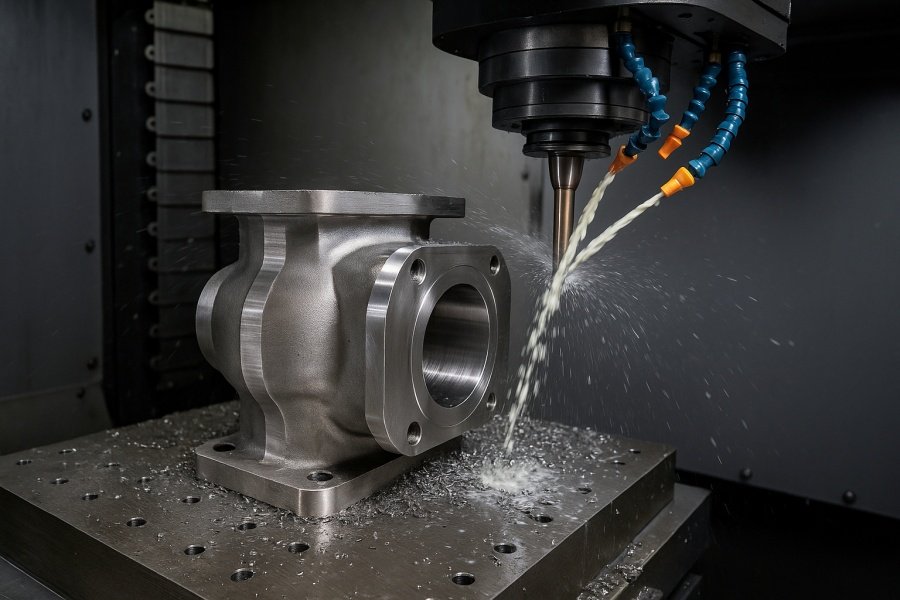The world of energy extraction demands equipment that can handle extreme pressures, corrosive environments, and relentless operation, making precision manufacturing a critical factor. Oil and gas CNC machining has become a cornerstone in the oil and gas sector, delivering components that withstand harsh conditions while boosting performance. From drilling rigs to pipelines, this technology ensures parts are crafted with exacting tolerances, cutting downtime and enhancing safety. This deep dive explores how CNC fits into oil and gas operations, spotlighting specifics like oil pans machining, and shares real-world applications that demonstrate its worth.
Applications and Roles of Oil and Gas CNC Machining
CNC machining relies on programmed software to guide tools in shaping materials such as steel, alloys, and composites. In oil and gas, this means creating parts that endure temperature swings from arctic cold to desert heat, all while managing corrosive fluids. Unlike manual methods of the past, CNC offers consistency—every valve, fitting, or flange emerges identical, reducing errors that could lead to leaks or breakdowns. This reliability makes it essential across upstream exploration, midstream transport, and downstream refining.
Precision in Challenging Environments
The ability to maintain accuracy under such conditions sets CNC apart. Whether it’s a subzero offshore platform or a scorching Middle Eastern field, the technology adapts. This consistency minimizes the risk of failures that could halt production or compromise safety, proving its value in an industry where every detail counts.

Spotlight on Oil Pans Machining
Consider oil pans machining as a standout example. Oil pans, the under-engine reservoirs collecting and circulating lubricants in machinery like drilling pumps or compressors, need intricate designs to handle fluid flow and heat dissipation. CNC shines here by milling complex contours and threads with micron-level precision. Traditional casting might leave rough edges or flaws, but CNC can carve reinforced ribs or integrated baffles to prevent sloshing during vibrations. This not only extends the pan’s durability but also improves system efficiency, potentially lowering maintenance costs in remote oil fields where every operational hour matters.
Enhancing Efficiency with Design
The added features from CNC, like baffles or reinforced sections, play a key role in keeping machinery running smoothly. This efficiency can translate to significant savings, especially in operations where downtime equates to lost revenue.
Broader Applications in Oil and Gas Machining
Beyond oil pans, oil and gas machining encompasses a wide range of components, from blowout preventers to subsea connectors. These often require tough materials like Inconel or Hastelloy, which are challenging due to their hardness. CNC’s multi-axis capabilities handle these alloys seamlessly, creating features like helical grooves or tapered bores for tight seals under high pressure. On offshore platforms, where space is limited and mistakes can be disastrous, this precision translates to safer operations and reduced environmental risks.
Real-World Success Stories
Real-world examples bring this to life. Take a North Sea drilling operation plagued by valve failures that halted production. Switching to CNC-machined valves with optimized designs cut wear by 40%, enabling uninterrupted flow. Or consider shale gas extraction in the Permian Basin, where custom CNC parts for hydraulic fracturing tools—like precision nozzles and manifolds—have increased injection rates while resisting abrasive fracking fluids. These insights, drawn from industry reports, show how targeted machining trims operational costs by streamlining assembly and minimizing waste.
Prototyping and Innovation in the Industry
Oil and gas industry machining also excels in prototyping. When developing new extraction technologies, such as enhanced oil recovery systems, engineers can quickly iterate designs with CNC. A prototype manifold might start as a digital model, be machined in days, and tested under simulated pressures. This speed accelerates innovation, helping adapt to shifting market demands or regulatory shifts. For example, in the push toward lower-carbon operations, CNC has played a role in crafting lightweight components for carbon capture equipment, blending traditional oil tech with greener solutions.
Speeding Up Development
This rapid prototyping capability allows for testing and refinement without long lead times, a critical advantage in an industry racing to meet evolving standards.
Challenges and Future Trends
Challenges do arise. Machining for oil and gas often involves large-scale parts, requiring robust CNC setups that maintain accuracy under heavy loads. Material choices are crucial—balancing cost with performance in corrosive settings. Compliance with standards like API adds another layer of complexity. Yet, innovations like hybrid CNC-additive manufacturing are tackling these issues, enabling even more intricate geometries beyond traditional limits.
Looking Ahead with Automation
Looking forward, as the industry ventures into deeper waters or tougher terrains, CNC’s role will expand. Automation, including AI-driven toolpath optimization, promises tighter tolerances and faster production. For those in energy projects, grasping these techniques isn’t just technical—it’s about building resilience into the supply chain.
Conclusion: Precision That Powers Progress
Ultimately, CNC machining in oil and gas delivers parts that keep energy flowing reliably. Whether refining an oil pan’s design or engineering a pipeline connector, the focus stays on precision that drives progress. As the sector evolves, embracing these tools will be vital for meeting future challenges. For more insights or collaboration opportunities, reach out to industry experts in the field.
